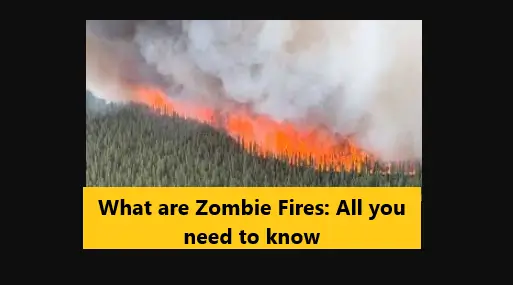What are Zombie Fires: All you need to know
Zombie Fires: The Undergound Threat Fueling Canada’s Wildfire Woes
While winter holds Canada in its icy grip, a hidden menace lurks beneath the surface: zombie fires.
These smoldering holdovers from last year’s scorching season pose a significant threat to the upcoming summer, raising concerns about the future of Canada’s forests.
What are Zombie Fires?
Unlike the roaring infernos we typically associate with wildfires, zombie fires burn underground, fueled by peat and dead organic matter. They may not boast towering flames, but their presence is evident in plumes of smoke rising from the earth. These holdovers can persist for months, even under a blanket of snow, due to:
- Thick layers of organic matter: Boreal conifer forests, prevalent in Canada, Alaska, and other northern regions, are characterized by a deep layer of needles and other organic material, creating ideal fuel for underground fires.
- Highly flammable peat: The soil in these areas often contains peat, a precursor to coal known for its flammability. When wildfires erupt, they can easily spread underground and smolder within the peat layers.
- Limited moisture penetration: Even snowfall may not provide enough moisture to reach and extinguish these deep-seated fires, especially when the soil is dry.
Climate Change and the Rise of Zombie Fires:
Wildfires are a natural part of the ecological cycle in conifer forests, promoting regeneration. However, climate change fueled by human activity has disrupted this balance, leading to:
- Increased frequency and intensity of droughts and heatwaves: The Arctic, in particular, has warmed at an alarming rate, leading to drier and hotter conditions that exacerbate wildfires.
- More persistent zombie fires: The hotter and drier summers leave behind more smoldering underground fires that carry over into winter. Research suggests a correlation between hot summers and increased numbers of zombie fires in subsequent winters.
- Exacerbated climate change: Zombie fires contribute to climate change by releasing greenhouse gases like carbon dioxide back into the atmosphere, creating a vicious cycle.
The Looming Threat of Spring and Summer:
The presence of zombie fires in winter raises serious concerns for the upcoming spring and summer:
- Early wildfire season: The presence of smoldering fires can trigger the wildfire season earlier than usual. A single gust of wind can reignite these underground fires and spark surface-level blazes come spring.
- Heightened danger in dry conditions: The risk is further amplified by dry springs or reduced winter snowpack, as less moisture is available to extinguish the embers once the snow melts.
- Difficult to extinguish: Effectively extinguishing zombie fires is no mean feat. Due to their deep location in densely packed material, water alone is rarely sufficient and can leave behind smoldering embers. Specialized techniques often involving removing layers of affected soil are needed.
The Way Forward:
Addressing the issue of zombie fires requires a multi-pronged approach:
- Mitigation strategies: Combating climate change by reducing greenhouse gas emissions is crucial for mitigating the problem at its root.
- Improved monitoring and prediction: Enhanced monitoring capabilities to detect and track zombie fires, coupled with advanced prediction models to assess wildfire risks, are essential for early intervention.
- Effective management techniques: Continuously developing and refining methods for extinguishing zombie fires through innovative technologies and strategic approaches is vital.
By acknowledging the threat posed by zombie fires and taking action on multiple fronts, we can better protect our forests, communities, and future from the devastating impacts of wildfires.
Note: The information above might not be accepted 100%. Please verify from your own sources. We will not be responsible for any kind of loss due to our content.
For more news, please visit Munafa Marketing.




